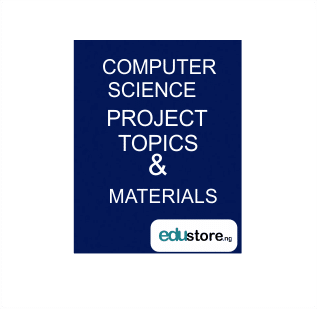Computer Science Project Topic and material titled – Design And Implementation Of An On Line Multi Media Based Electronic Learning System For Post Primary Educational Institutes.
TABLE OF CONTENTS
Title Page……………………………………………………………………………i
Approval page ……………………………………………………………………ii
Dedication…………………………………………………………………………..iii
Acknowledgement………………………………………………………………iv
Abstract……………………………………………………………………………….v
Table of content……………………………………………………………………
CHAPTER ONE
1.0 Introduction
1.1 background of study
1.2 Statement of the problem
1.3 Objective of the Study
1.4 Significance of Study
1.5 Scope of the Study
1.6 Limitation of the Study
1.7 Definition of the Study
CHAPTER TWO
2.1 Review of Related Works
2.2 History of Computer Assisted Learning Instruction
2.3 Significance of online Computer Assisted Learning Instruction
2.4 Views on E-Learning System
2.5 Approaches to E-Learning Services
2.6 Communication Technologies used in E-Learning
2.7 Categories of E-Learning
CHAPTER THREE
3.1 Analysis of Existing System
3.2 Weakness of the Existing System
3.3 Justification for a New System
3.4 Analysis of the Proposed System
3.5 Advantages of the proposed system
3.6 Dataflow diagram of the proposed system
3.7 Methodology
3.8 Methodology adopted
3.9 High level model of the propose system
CHAPTER FOUR
4.1 Review of System Design
4.2 Objective of the Design
4.3 Decomposition and Cohesion of the High Level Model
4.4 Specification
4.5 Implementation Plan
4.6 System Requirement
4.7 Choice of Programming Language
4.8 System Conversion
CHAPTER FIVE
5.1 Summary
5.2 Conclusion
5.3 Recommendation
References
Appendix
ABSTRACT
In order to ensure effective learning, there must be a need to automate the system thereby transforming the normal teaching system into a computer assisted learning system. This work focused on the implementation of a multimedia based e-learning system. The current learning environment which consists of non-information technology devices, is uncomfortable for students especially with verbal defects, also is prone to external noise interference which leads to distraction of both students and teachers. The result of this work is the design of an online multimedia eLearning system that will enable student to undertake classroom learning activities at their own pace. The methodology adopted in this project was in line with the Object oriented analysis and design method (OOADM). Object-oriented analysis and design method is the principal industry-proven methodology for developing high-quality object-oriented systems, which are systems that are composed of interacting objects. It is a way of organizing software as a collection of discrete objects that incorporate both data structure and behaviour. The development tool is Sublime Text 4. The language used is PHP for the server side development of the dynamic content, MySQL is used for the database design, HTML, CSS and JavaScript enabled the development of the static content of the web pages and the building of forms as well and to improve the client side effect.
CHAPTER ONE
INTRODUCTION
1.1 Background of Study
Due to the rapid technological growth and changes that occurred in recent years, electronic learning and training facilities are now gaining grounds, not merely supportive to the traditional classroom system, but as an accepted system implemented by powerful institutions that offer global services. It is discovered that people, especially Africans prefer watching and listening to trainings than reading. (Tunner et al,2008).
E-learning is the use of electronic media and Information and Communication Technologies (ICT) in education. Universities are forced to respond to the emerging developments in Information and Communication Technology (ICT). The Internet is fast becoming an everyday tool for life activities. The use of internet for teaching and learning is becoming a normal extension. Students also have high expectations about the use of ICT in their education. The shift in learner expectations, changing demographics of learners, and the rapid development of subject knowledge forms challenges to universities.
E-learning is an inclusive term that describes educational technology that electronically or technologically supports learning and teaching. Bernard Luskin, a pioneer of e-learning, advocates that the “e” should be interpreted to mean “exciting, energetic, enthusiastic, emotional, extended, excellent, and educational” in addition to “electronic.” This broad interpretation focuses on new applications and developments, and also brings learning and media psychology into consideration. Parks suggested that the “e” should refer to “everything, everyone, engaging, easy”.
E-learning encompasses multimedia learning (MML), technology-enhanced learning (TEL), computer-based training (CBT), computer-assisted instruction (CAI), internet-based training (IBT), web-based training (WBT), online education, virtual education, virtual learning environments (VLE) which are also called learning platforms, m-learning, digital educational collaboration, distributed learning, computer-mediated communication, cyber-learning, and multi-modal instruction.
Developments in internet and multimedia technologies are the basic enabler of e-learning, with consulting, content, technologies, services and support being identified as the five key sectors of the e-learning industry. E-learning mainly takes the form of online courses, where the dominant learning technology employed today is a type of system that organizes and delivers these courses. E-learning includes numerous types of media that deliver text, audio, images, animation, and streaming video, and includes technology applications and processes such as audio or video tape, satellite TV, CD-ROM, and computer-based learning, as well as local intranet/extranet and web-based learning. Information and communication systems, whether free-standing or based on either local networks or the Internet in networked learning, underlay many e-learning processes.
Following this trend, technology is now geared up to enhance e-learning through online video training centers where students have access to recorded classes or computer recorded demonstration videos (Tunner et al,2008). Offline training system is good and still practiced in most part of the world but the revolution of internet and enhanced networking systems which include efficient video streaming and voice over internet technologies have really expanded the scope and coverage of training centers. Most schools now not only accommodate foreign students but also extend their training facilities through the internet. Students can thus register and enroll for programmes and attend classes online and can as well obtain their certificates upon graduation without necessarily visiting the school.
The development of online classes was a boom in the training industry. Busy businessmen and office workers at last can attend classes even at their own comfort and less expense. To modern schools, online training platform is a necessity.
It is a well-known fact that the internet is the greatest advancement in the computing world. Originally designed for the American military, the internet technology keep evolving and improving on daily basis. New possibilities were discovered by scientists and implemented as business solutions to organizations and the Government. Development of advanced network devices, programs and protocols enhance data transmission and retrieval over wide areas (Hubbard, 2009). Internet calls, instant messaging, chats and video streaming took the lead in information sharing. Some schools later extended this technology to real-time online training (Simeon, 2009).
All that is needed to participate in online training is a good internet facility by the student. The school should maintain the online classes and provide clear and recent video tutorials for visiting students. Despite the convenience of online e-learning, most people still prefer the traditional classroom system due to factors like ignorance, inadequate internet connectivity and the quest to pass through the stimulating-though-stressful and high-bandwidth classroom system where they run to lectures, struggle for seats and physically interact with both teachers and students.
The purpose of this project is to come up with an e-learning facility for an online training system using video elements. Our system has tools and resources that allow students in post-primary educational institutes to watch recorded videos of classroom teaching on different subjects. The system will provide features for the trainer or management to create and manage his database of subjects, students, lecture materials like video tutorials, exams, as well as track to monitor student performance and activities through discussion forums, personal chats and email messaging.
1.2 Statement of the Problem
The need for an effective means of learning between students and their lecturers gave birth for the need of this new proposed system, whereby students can study at their own convenience. The current learning environment which consists of non-information technology devices, is uncomfortable for students especially with verbally understanding difficulty, also the present learning environment is prone to external noise interference, which leads to distraction of both students and lecturers and vitally the feedback from the students are not immediate and there is no exposure to the current ICT trend, on how to make learning a very easy process
1.3 Objective of the study
The objective of this study is to design and develop an online multimedia based e-learning system for post-primary educational institutes. This system which will be online will perform functions such as:
- Provide tutoring for students using multimedia, image, text and animations
- Enable learning materials to be shared online at convenience
- Allow students to learn at their own pace, having opportunity to re-visit topics over and over again.
1.4 Significance of Study
A Computer Interactive Learning System that supports teaching through multimedia will significantly benefit teachers and students in a learning environment.
The system will enhance learning for secondary schools; make assimilation faster through text, image, audio and video for students.
- Scope of the Study
The scope of study of this research will basically cover the following areas:
- An Interactive GUI Interface
- A modified video introduction to the application
- An Outlined topics of each tutorial to be presented
- A navigation system for accessing topics to and fro
- An exercise writing system.
- Limitation of the Study
The difficulties encountered and why I could not cover the listed areas are as follows:
- Lack of availability of materials to expand my research.
- Inadequate and poor internet facilities.
- Epileptic power supply
- Definition of the Study
Administrator: Somebody that manages the affairs of an organization.
Assist: The act of helping.
Computer: An electronic machine that accepts and processes data.
Communication: Exchange of information between people.
Internet: A global computer network that links computers all over the world by satellite & telephone, connecting users with service networks such as e-mail and the World Wide Web.
Learning: The acquisition of knowledge or skill.
Online: Attached to an available central computer.
CLICK BLUE LINK TO SEARCH FOR MORE COMPUTER SCIENCE PROJECT TOPICS AND MATERIALS CHAPTER1-5 WITH SOURCE CODE
DOWNLOAD COMPLETE WORK- For Reference Only: Materials are for research, citation, and idea generation purposes and not for submission as your original final year project work.
- Avoid Plagiarism: Do not copy or submit this content as your own project. Doing so may result in academic consequences.
- Use as a Framework: This complete project research material should guide the development of your own final year project work.
- Academic Access: This platform is designed to reduce the stress of visiting school libraries by providing easy access to research materials.
- Institutional Support: Tertiary institutions encourage the review of previous academic works such as journals and theses.
- Open Education: The site is maintained through paid subscriptions to continue offering open access educational resources.






